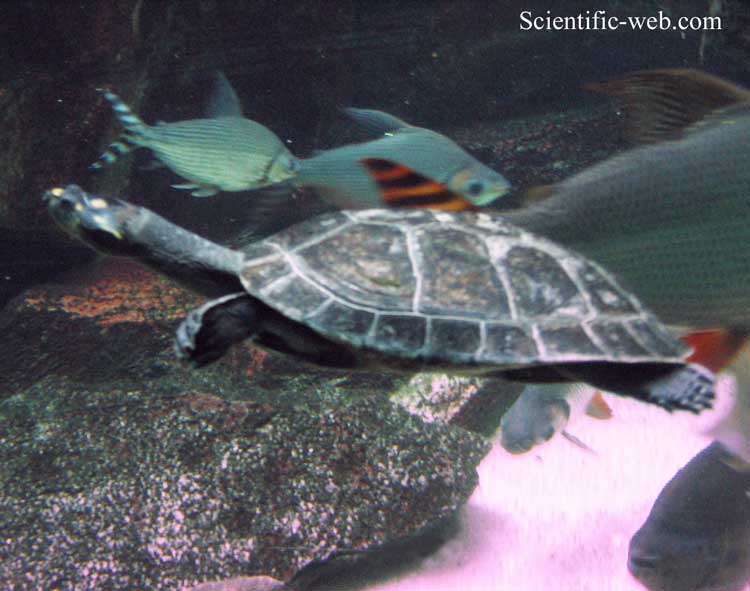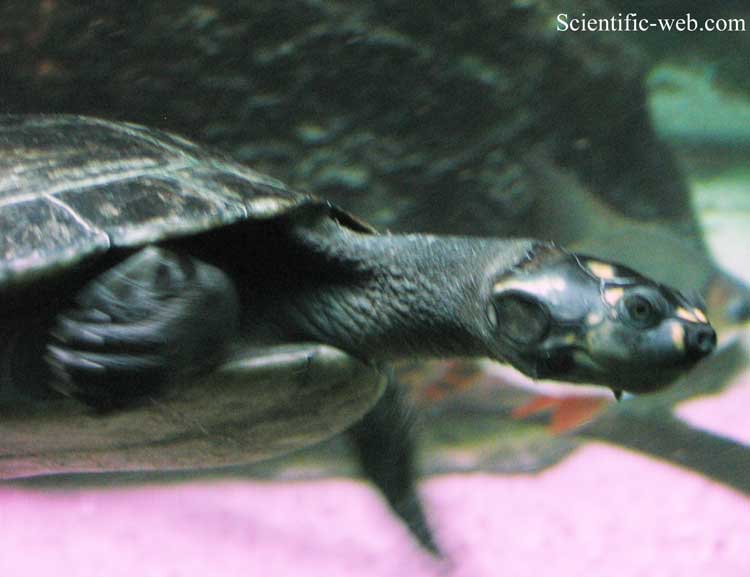
Podocnemis unifilis , Photo: Michael Lahanas
Superregnum: Eukaryota
Regnum: Animalia
Subregnum: Eumetazoa
Cladus: Bilateria
Cladus: Nephrozoa
Superphylum: Deuterostomia
Phylum: Chordata
Cladus: Craniata
Subphylum: Vertebrata
Infraphylum: Gnathostomata
Superclassis: Tetrapoda
Cladus: Reptiliomorpha
Cladus: Amniota
Classis: Reptilia
Cladus: Eureptilia
Cladus: Romeriida
Subclassis: Diapsida
Cladus: Sauria
Cladus: Archelosauria
Division: Pan-Testudines
Division: Testudinata
Ordo: Testudines
Infraordo: Pan-Pleurodira
Subordo: Pleurodira
Superfamilia: Pelomedusoidea
Familia: Podocnemididae
Genus: Podocnemis
Species: Podocnemis unifilis
Name
Podocnemis unifilis Troschel, 1848

Podocnemis unifilis , Photo: Michael Lahanas
Vernacular names
čeština: Tereka jednovousá
Deutsch: Terekay-Schienenschildkröte
English: Yellow-spotted river turtle, Yellow-headed sideneck turtle
日本語: モンキヨコクビガメ
português: Tracajá
The yellow-spotted Amazon river turtle[4] (Podocnemis unifilis), also known commonly as the yellow-headed sideneck turtle and the yellow-spotted river turtle, is one of the largest South American river turtles. It can grow up to 45 cm long and weigh up to 8 kg. This species can be recognized by its black or brown oval carapace (upper shell) with distinctive low keels on the second and third scutes. Yellow spots on the side of its head give this species its common name. These spots are most prominent in juveniles and fade with age. Females can be up to twice the size of males.
Podocnemis unifilis is a type of side-necked turtles, so called because they do not pull their heads directly into their shells, but rather bend their necks sideways to tuck their heads under the rim of their shells. Side-neck turtles are classified as members of the suborder Pleurodira.
Juvenile
These turtles are native to South America's Amazon and Orinoco basins, as well as rivers systems of the Guianas.[5] They are found in tributaries and large lakes, naturally calm waters. During flood season, they may venture into flooded forests or floodplain lakes. They feed on fruits, weeds, fish, and small invertebrates.
The females lay two clutches of eggs each year, each with four to 35 eggs in it. They make their nests in sandy areas on the banks of rivers, where the eggs will hatch 66 to 159 days after they are laid. The eggs are laid at the peak of dry season so the nest will not be washed away with the floods of the rainy season. Eggs incubated below 32 degrees Celsius will hatch as males, while those incubated above 32 degrees Celsius will hatch as females. Within a few days after hatching, the young turtles begin to forage for food alone. This food includes vegetable matter, grasses, fruits, leaves, carrion and mollusks.
Podocnemis unifilis was one of the foreign species exploited by the American pet turtle trade in the 1960s. This species is at risk of predation by humans, birds, snakes, large fish, frogs and mammals.[6] Importation of this species is now strictly regulated by federal law, but a captive, self-sustaining population exists in the United States—some groups in zoos, others in the hands of private collectors. Individuals of this species have lived more than 30 years in captivity.
References
Troschel, H. (1848). Amphibien, p. 645-661. In Schomburgk, R. (ed.), Versuch einer Zusammenstellung der Fauna and Flora von Britisch-Guiana. Leipzig.
Schweigger, A.F. (1812). Prodromus monographiae cheloniorum. Konigsbergeiv Für Naturwissenschaften und Mathematik. 1:271-368.
Gray, J.E. (1831). Synopsis Reptilium or short descriptions of the species of reptiles. Part 1. Cataphracta, tortoises, crocodiles, and enaliosaurians. Treuttel, Wurtz & Co., London.
Podocnemis unifilis, Reptile Database
Rhodin, A.G.J., Iverson, J.B., Bour, R. Fritz, U., Georges, A., Shaffer, H.B., and van Dijk, P.P. (Turtle Taxonomy Working Group) (2017). Rhodin, A.G.J.; Iverson, J.B.; van Dijk, P.P.; et al. (eds.). "Turtles of the World: Annotated Checklist and Atlas of Taxonomy, Synonymy, Distribution, and Conservation Status". Chelonian Research Monographs. Conservation Biology of Freshwater Turtles and Tortoises: A Compilation Project of the IUCN/SSC Tortoise and Freshwater Turtle Specialist Group (8 ed.). 7: 1–292. doi:10.3854/crm.7.checklist.atlas.v8.2017. ISBN 9781532350269.
"Yellow-headed sideneck turtle videos, photos and facts - Podocnemis unifilis". Arkive. Archived from the original on 2009-02-20. Retrieved 2018-05-09.
[1] Yellow-headed sideneck turtle (Podocnemis unifilis). (n.d.). Retrieved April 16, 2018, from [https://web.archive.org/web/20090220152911/http://www.arkive.org/yellow-headed-sideneck-turtle/podocnemis-unifilis/ ARKive]
Tortoise & Freshwater Turtle Specialist Group (1996). "Podocnemis unifilis". IUCN Red List of Threatened Species. 1996: e.T17825A97397562. doi:10.2305/IUCN.UK.1996.RLTS.T17825A7506933.en.{{cite iucn}}: Listed as Vulnerable (VU A1acd v2.3)
Ernst, Carl H., and Roger W. Barbour (1989). Turtles of the World, Smithsonian Institution Press, Washington, D.C., and London.
Retrieved from "http://en.wikipedia.org/"
All text is available under the terms of the GNU Free Documentation License

